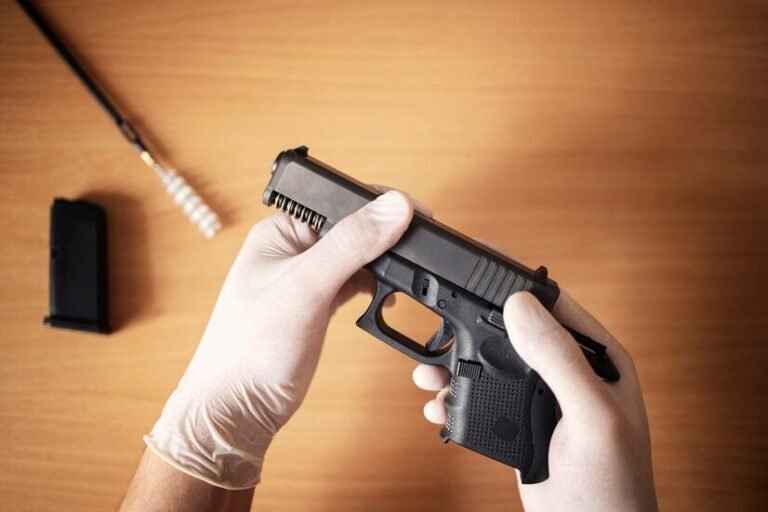The Kimber Micro 9 has gained a lot of popularity for its compact design, making it an excellent choice for concealed carry. Known for its smooth operation, sleek aesthetics, and impressive performance, the Micro 9 has won the hearts of gun enthusiasts and everyday carriers alike. However, like any firearm, it’s not immune to occasional issues. Whether you’re a first-time user or an experienced gun owner, knowing about potential problems with the Kimber Micro 9 can help you troubleshoot and improve your overall shooting experience.
We’ll take a deep dive into some of the most common Kimber Micro 9 problems and offer solutions to address them. By understanding these issues and how to fix them, you can ensure that your firearm remains in optimal condition and continues to perform reliably when you need it most.
Feeding Issues
One of the most frequently reported problems with the Kimber Micro 9 is related to feeding issues. This can include the failure of rounds to feed properly into the chamber, causing jams or misfeeds during shooting.
Causes of Feeding Problems
- Magazines: One of the most common causes of feeding problems is a faulty or dirty magazine. If the magazine spring is weak or dirty, it may fail to properly push the rounds into the chamber. Additionally, magazines that are not properly seated can also cause feeding issues.
- Limp-Wristing: The Kimber Micro 9 is a lightweight, compact firearm, and it requires a firm grip to function correctly. If you don’t hold the gun firmly enough, the slide may not cycle fully, causing a failure to feed.
- Ammo Type: Certain types of ammunition may not feed smoothly through the Kimber Micro 9. For instance, hollow-point rounds or low-velocity ammo can sometimes cause issues. The Micro 9 is typically more reliable with high-quality FMJ rounds.
Solutions to Feeding Problems
- Check the Magazines: Regularly clean your magazines to ensure that there is no dirt or debris interfering with their function. Also, make sure the magazine is fully inserted into the grip of the gun.
- Improve Grip: Practice a firm grip when firing the Micro 9 to prevent limp-wristing, which can lead to feeding failures.
- Use Quality Ammo: Stick to high-quality, brass-cased full metal jacket (FMJ) ammunition to avoid issues with feeding. If you’re using hollow-point ammunition, ensure that it is of good quality and specifically designed for semi-automatic pistols.
Failure to Eject (FTE)
Another common issue faced by Kimber Micro 9 owners is a failure to eject, or FTE. This occurs when the spent casing doesn’t fully eject from the chamber after firing a round.
Causes of FTE
- Weak Recoil Spring: The recoil spring in the Kimber Micro 9 plays a critical role in ensuring the slide cycles properly after each shot. If the recoil spring is worn or weak, it may not have enough force to eject the spent casing.
- Dirty Chamber: A dirty chamber can cause the spent casing to get stuck, preventing it from being ejected properly. Carbon buildup and residue can make extraction more difficult.
- Ammo Issues: As with feeding problems, the type of ammunition you’re using can impact the performance of your firearm. Low-velocity rounds may not provide enough force to properly eject the spent casing.
Solutions to FTE
- Replace the Recoil Spring: If the recoil spring is old or damaged, replace it with a new one to ensure proper cycling. The Kimber Micro 9 may require a more frequent spring replacement due to its compact size and light recoil spring tension.
- Clean the Chamber: Regularly clean the chamber to remove any carbon buildup, residue, or debris that could impede the ejection process.
- Use Higher Velocity Ammo: Choose ammunition with higher velocity to ensure proper functioning and reliable ejection.
Light Primer Strikes
A light primer strike occurs when the firing pin doesn’t strike the primer of the round with enough force to ignite the powder, resulting in a misfire. This issue, though relatively rare, can still occur in the Kimber Micro 9 Problems.
Causes of Light Primer Strikes
- Firing Pin Issues: A worn or damaged firing pin can fail to strike the primer with sufficient force. This is more common with older models or firearms that have experienced extensive use.
- Dirty Firing Pin Channel: Dirt and debris buildup in the firing pin channel can prevent the firing pin from moving freely, resulting in weak or inconsistent strikes.
- Ammo Quality: Poor-quality ammo with soft primers may also cause light strikes, especially if the primers are inconsistent or weakly seated.
Solutions to Light Primer Strikes
- Inspect and Clean the Firing Pin: Regularly inspect the firing pin for wear and clean the firing pin channel to ensure smooth operation. A dirty firing pin channel can impede the firing pin’s ability to strike the primer with enough force.
- Use High-Quality Ammo: Always use high-quality, reliable ammunition from trusted brands. Poor-quality ammo can lead to misfires and other issues.
- Replace Worn Firing Pin: If the firing pin appears worn or damaged, it’s essential to replace it promptly to prevent future problems.
Slide Lock Failure
Some Kimber Micro 9 owners have reported issues with the slide lock not engaging correctly after the last round is fired. This prevents the slide from locking back, signaling that the magazine is empty.
Causes of Slide Lock Failure
- Magazine Followers: The slide lock mechanism is often engaged by the magazine follower, which presses against the slide stop lever. If the follower is worn or damaged, it may not engage the lever correctly, leading to a failure to lock the slide.
- Weak or Malfunctioning Slide Stop: The slide stop itself could be defective, preventing it from catching the slide when the magazine is empty.
Solutions to Slide Lock Failure
- Inspect the Magazine: Check the magazine followers for wear and tear. Replacing a worn magazine can resolve this issue.
- Examine the Slide Stop: Inspect the slide stop for any damage or wear. If the slide stop is worn, it may need to be replaced to ensure proper functioning.
Trigger Pull Issues
Another problem that some Kimber Micro 9 owners experience is an inconsistent or heavy trigger pull. This can affect accuracy and overall shooting comfort, especially for those who prefer a lighter trigger for concealed carry situations.
Causes of Trigger Pull Issues
- Heavy Trigger Spring: The trigger spring may be too heavy, creating a hard or inconsistent pull.
- Internal Components: Wear and tear on the internal trigger components, such as the sear or hammer, can cause irregular trigger pulls.
- Poor Lubrication: Lack of proper lubrication or dirty components can cause friction in the trigger mechanism, resulting in a heavy or irregular pull.
Solutions to Trigger Pull Issues
- Clean and Lubricate the Trigger Mechanism: Regularly clean and lubricate the trigger assembly to ensure smooth operation.
- Consider a Trigger Job: If the trigger pull is too heavy or inconsistent, consider having a professional gunsmith perform a trigger job to improve the pull weight and smoothness.
- Replace Worn Components: Over time, parts like the sear or hammer can wear out. If this is the case, replacing worn internal components can solve the problem.
Accuracy Problems
While the Kimber Micro 9 is generally known for its accuracy, some owners may experience inconsistent or poor accuracy, especially at longer distances.
Causes of Accuracy Problems
- Grip and Stance: The small size of the Micro 9 can make it harder to achieve a solid grip, which can lead to accuracy issues. Additionally, an improper stance can contribute to poor shooting performance.
- Sight Alignment: Poor sight alignment or a misaligned rear sight can affect accuracy, especially if the sights shift out of alignment during use.
- Ammunition: The type of ammo you use can also impact accuracy. Low-quality or improperly-sized rounds may not provide the best performance.
Solutions to Accuracy Problems
- Improve Grip and Stance: Make sure you’re using proper shooting techniques, with a firm grip and a stable stance. Practicing regularly can improve your shooting accuracy.
- Adjust or Replace Sights: Check the sights for alignment, and adjust them if necessary. If the sights are damaged or not ideal for your preferences, replacing them with aftermarket options may improve accuracy.
- Use Quality Ammo: Using the best possible ammunition, tailored for your specific gun, will often result in improved accuracy.
Conclusion
The Kimber Micro 9 is a high-quality, reliable firearm that many shooters choose for concealed carry. However, like any mechanical device, it’s not without its potential issues. Understanding common Kimber Micro 9 problems—such as feeding failures, light primer strikes, ejection issues, and more—can help you troubleshoot and resolve them before they become significant obstacles. Regular maintenance, high-quality ammo, and proper shooting techniques are essential for keeping your firearm in top condition.
If you want to read more, visit our site. We have more topics!
FAQs
How can I prevent feeding issues with my Kimber Micro 9?
Make sure to clean your magazines regularly, use high-quality ammo, and maintain a firm grip while shooting to avoid limp-wristing.
My Kimber Micro 9 jams frequently; what should I check?
Check your recoil spring, clean the chamber, and ensure your magazines are in good condition. Also, try using higher velocity ammo.
How often should I replace the recoil spring in my Kimber Micro 9?
Typically, the recoil spring should be replaced every 2,000 to 3,000 rounds, but this can vary depending on usage and condition.
What type of ammo is best for the Kimber Micro 9?
Full metal jacket (FMJ) rounds are the most reliable for the Kimber Micro 9, but high-quality hollow-point ammo designed for semi-automatics can also work well.
Why is my Kimber Micro 9’s trigger pull heavy?
A heavy trigger pull may be due to a worn or improperly lubricated trigger mechanism. Consider cleaning and lubricating the parts or seeking a professional trigger job.

